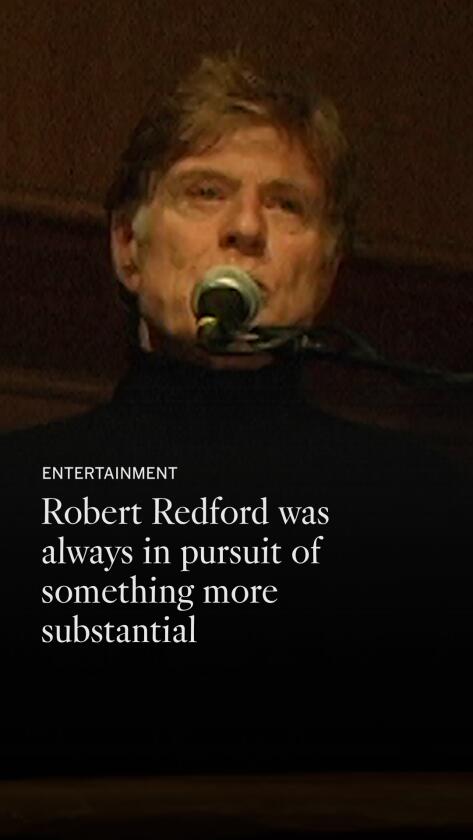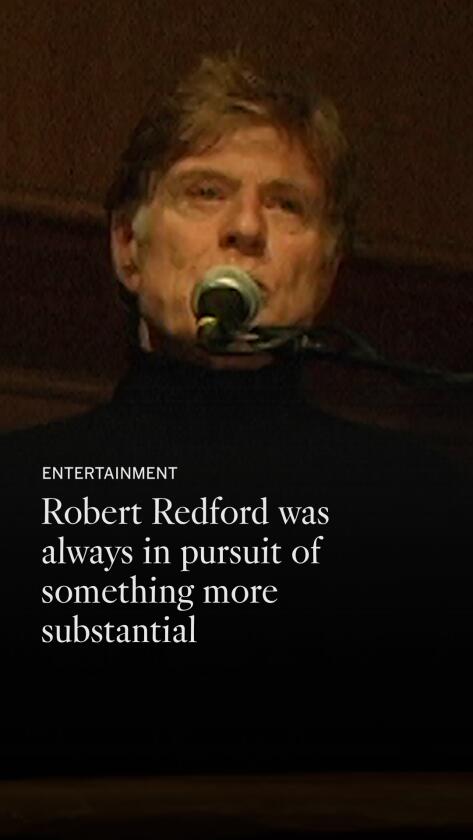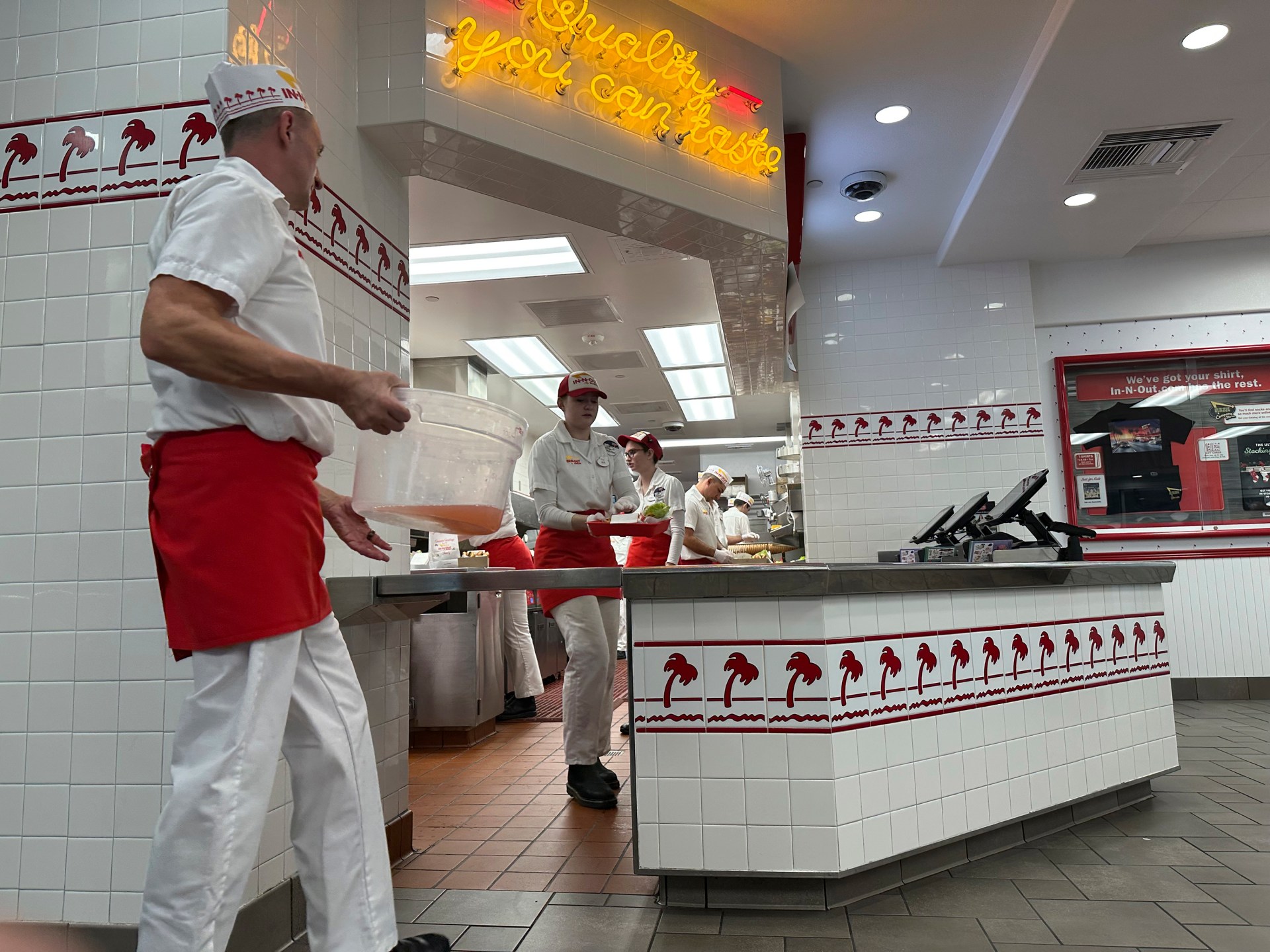Robert Redford undermined his good looks with admirable riskiness
Robert Redford looked like he walked out of the sea to become a Hollywood god. He was physically flawless. Pacific blue eyes, salt-bleached hair, a friendly surfer-boy squint. Born in Santa Monica to a milkman and a housewife, his first memory was of sliding off his mother’s lap at the Aero Theatre as a toddler and running toward the light, causing such a ruckus that the projectionist had to stop the film.
He definitely grew up to grab the movies’ attention. He wasn’t just telegenic but talented, although that wasn’t a requirement for stardom when he emerged in the late ’50s when the industry was scooping up hunks like him by the bucket for television and B-movies. All a male ingenue needed to do was smile and kiss the girl. It would have been so easy to do that a couple times and wind up doing it forever. You can understand why so many forgotten actors made that deal, without realizing that forever can lead to a fast retirement.
But if Redford had sensed at 2 years old that he was meant to be onscreen, by his 20s, he insisted he’d only do it on his own terms. At 27, with nearly zero name recognition, he horrified his then-agent by turning down a $10,000-a-week TV gig as a strait-laced psychiatrist to do a Mike Nichols theater production for just $110. His rejection of the easy money was an unusual choice, particularly for a cash-strapped father of two.
To appreciate Redford fully, we have to applaud not only the work he did but the simple, feel-good roles he rejected. He could have become a celebrity without breaking a sweat as the war hero, the jock, the husband, the cowboy, the American ideal made incarnate. Yet, he had the rare ability to sidestep what audiences thought we wanted from him to instead give us something we didn’t know we needed: selfish victors (“Downhill Racer”), self-destructive veterans (“The Great Waldo Pepper”) and tragic men who did everything right and still failed (2013’s “All Is Lost”).
In spirit, Redford never strayed far from the teen rebel he’d been — a truant who’d skipped school, stole booze and crashed race cars — and the radical artist he hurled himself into becoming by quitting everything traditional (the football team, his fraternity, college altogether) to move to Paris where he took up oil painting and marched against the Soviets. He might have excelled at the sleazy roles that made Dustin Hoffman and Al Pacino famous. On the outside, he knew they didn’t fit, either.
Sometimes Redford said no even when I wish he’d have said yes. Imagine if he’d agreed to face off against Elizabeth Taylor and Richard Burton in “Who’s Afraid of Virginia Woolf?” Instead, he told Nichols he’d rather tangle with Anne Bancroft in “The Graduate,” only to be rejected as too handsome for the role. “Can you honestly imagine a guy like you having difficulty seducing a woman?” Nichols told him.
Instead, Redford used his all-American good looks to make us question our flattering image of ourselves. In the 1974 adaptation of “The Great Gatsby,” he was the first person you’d think of to play the title role because he fully understood the point of F. Scott Fitzgerald’s book — how it felt to represent our country’s whole image of success while knowing it’s a phony put-on. I imagine him making a devil’s bargain with his face, vowing that he won’t hide behind goofy accents and stunt wigs the way other too-handsome oddballs do, if he’s allowed to use his appeal like a Trojan horse.
If there’s one thing that unites his roles, from 1966’s “The Chase” to “Lions for Lambs,” it’s his willingness to give the screen his full charisma — to let audiences stare at him for the whole running time of a movie — as long as we’ll agree to ask what’s lurking in his underbelly. Most often, we’ll find frustrated idealism just at the moment it starts to sour.
-
Share via
The films of the 1960s and ’70s that made Redford an icon mostly cleave into two categories: scamps and truth-seekers. (The latter can overlap with suckers and stooges.) His antihero crooks in “Butch Cassidy and the Sundance Kid” and “The Sting” captured something in our national id, our not-so-secret belief that it’s OK to break a few rules to get ahead — that we can forgive a sin if we like the sinner. I like how those movies give you a guilty little tingle about rooting for Redford even when it means scratching off a couple of the Ten Commandments. (Thou shalt not steal unless you’re Robert Redford, who got away with it all the way through 2018’s “The Old Man and the Gun.”)
Lately, the Redford roles I’ve been thinking about are the ones where his all-American appeal makes us examine all of America, good and bad. The two that instantly jump to mind are his pair of political thrillers: “Three Days of the Condor,” in which he plays a CIA agent on the run from his own co-workers, and “All the President’s Men,” in which he doggedly uncovers the Watergate scandal. Both films believe in the power of getting the truth out to the press; neither is so naive as to think the truth alone will save the day.
But let’s not overlook “The Candidate,” a movie that has Redford as underqualified political scion Bill McKay, pressed to run for governor of California. “He’s not going to get his ass kicked — he’s cute,” his father (Melvyn Douglas) says. Meanwhile, his own campaign team cares more about the length of his sideburns than ideas in his head. Released in 1972, five years into former actor Ronald Reagan’s own governorship, the movie hammers home that superficiality might be democracy’s downfall — and the stakes are bigger than who is Hollywood‘s latest heartthrob.
Vice President Dan Quayle once said “The Candidate” inspired him, triggering its screenwriter Jeremy Larner to dash this off in an op-ed: “Mr. Quayle, this was not a how-to movie, it was a watch-out movie. And you are what we should be watching out for!”
In his later years, Redford became a filmmaker himself and I can picture him pulling Brad Pitt aside on the set of “A River Runs Through It” to whisper: You don’t have to stay in that pretty–boy box. Feel free to get weird. As an actor and director, Redford continued to create characters who uncovered our our hidden rot, whether in our purported national pastime, baseball (“The Natural”), or in our actual one, watching television (“Quiz Show”). His turn in “Indecent Proposal” as the wealthy man who offers to rent his employee’s wife lives on as shorthand for tycoons who assume they can buy whatever, and whoever, they want. When he eventually signed on for a superhero film, it was, fittingly, alongside Captain America, that upright paragon of virtue — and Redford played the villain.
What Quayle missed about “The Candidate” is that when it comes to a Robert Redford movie, truth is never as plain as what your eyes can see. There’s always a deeper level and there’s no guarantee that justice would win. In fact, I’d argue in Redford’s films, it rarely does.


